Day 20: Frascati
Following up on a suggestion made by our friend Maureen in Rome, we have an appointment to visit the Tenuta Pantano Borghese, an agriturismo and large farm located about 30 minutes from Frascati. After breakfast--surprisingly ordinary for such a classy hotel, we find the right road which climbs steeply to the next town of Monte Porzio Cantone and then descends sharply into the valley where the Via Casalina runs.
Tenuta Pantano Borghese
The farm is located behind a security gate and down a long road lined with plane trees. We meet the owners--Federico and Monica Cavazza and they take us on a tour of the property. There are 15 apartments (most of them recently refurbished and tastefully but simply furnished) and a large dining hall with a professional kitchen. In addition to taking in guests, the farm also hosts weddings and other large parties that Monica arranges. She tells us that she will be supervising a lunch for 150 people next week...as part of the inauguration of the fox hunting season (her husband is one the leaders of the local fox hunting group) which will be held on the property. In fact, she invites us to come--to watch the fox hunting but more to enjoy the homemade pasta.
In the back of the buildings--which are built on the foundation of an aqueduct that passed through the property--there are about 300 cows in pens. This is a working dairy farm although the owners are very critical of all the Italian and EU regulations which are constantly changing and making it difficult for them to farm. In fact, they will start marketing their milk directly because the current agricultural policy has been paying them not to produce and they want to keep the farm going as a working farm as well as an agriturismo.
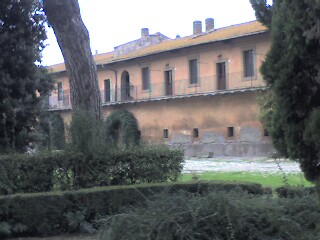
Tenuta Pantano Borghese main building
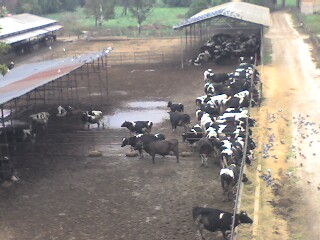
Cows in pens in back of Tenuta Pantano Borghese
It turns out that Federico is a Borghese count and the farm has been in his family since the 1600's. Monica and Federico invite us for some coffee and cake and we hit it off very well. We have a very pleasant chat about the travel business, the difficulties connected with operating a farm, their experience with getting the business started as well as their family trip around New England and Quebec in a motor home last summer. After our tour of the apartments, Federico invites us to come with him to another horse club event--where many of the members of the fox hunting set get together for a show of the horses that are being used this year as well as demonstration of jumping and cross-country racing.
We follow him from Pantano Borghese to the horse club...which is located just inside the ring road that goes around Rome and just off the Appian Way. The setting is in a very green and bucolic area, almost within the city limits of Rome. In order to get to the stables, we actually have to drive for a short way on the Appian Way with the old stones in the roadway.
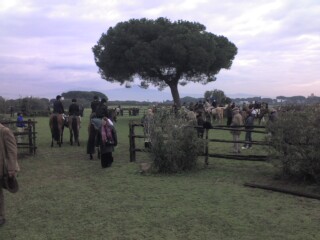
A wide view of the riding area
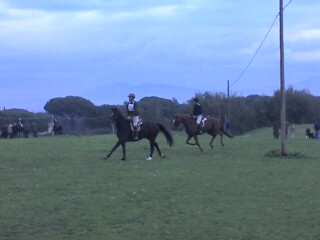
Riders galloping across the fields
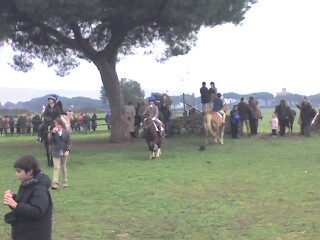
The riders of the future
This is a glimpse into a piece of Italian life that we didn't even know existed....fox hunting was brought to Italy about 100 years ago. The people we see at this event are both Italians and foreigners--but from their dress, we could be somewhere in England. We watch the jumping and the riding for a while--many of the riders at this event are policemen and military--and then thank Federico and say goodbye. He urges us to come back to Pantano Borghese next week for the first fox hunt of the season.
We drive back to Frascati for lunch....the porchetta stands in the Piazza del Mercato are too inviting. On this overcast Sunday afternoon, Frascati is very lively....there is a monthly craft/antique sale that fills the main piazza and the streets of the "centro storico". There are four porchetta stands open but one of them is staffed by a natural salesmen who hawks his product aggessively and offers tastes to all who walk by. We order two sandwiches--delicious moist roast pig with savory spices in the middle and crispy skin on wonderful, fresh rosetta rolls--and eat them on a bench in the square.
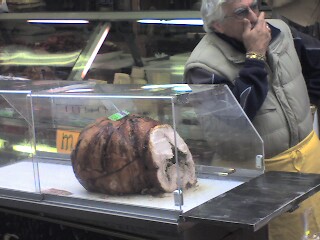
Porchetta
After lunch, we drive back into Rome; it is Sunday afternoon and the traffic is quite light. My goal is to see the Via Appia Antica (Appian Way) and the memorial at the Ardeatine Caves (Fosse Ardeatine) where more than 300 Romans were massacred as a reprisal for a partisan bomb that killed 33 German soldiers in 1944. I drive straight down the Via Appia Nuova almost to the center of Rome, go past San Giovanni Laterano and down to the Circus Maximus. Along the west side of the Via Appia Nuova, it is still undeveloped for a long stretch and you can see the remains of Roman buildings in the fields. The Via Appia Antica is closed to car traffic until 4 pm (another half hour) so I try to negotiate the confusing Rome traffic patterns to get as close to some of the monuments as possible. After wandering around a residential neighborhood for a while, we find ourselves right along the wall near the Porta San Sebastiano and follow the traffic right onto the Appian Way (even though it is a bit before 4 pm.) The road at this point is lined with high walls and it hard to see anything. We pass the Ristorante Quo Vadis and soon come to the catacombs of St. Calisto....there are a lot of tour buses and a good number of tourists there. Continuing on, we reach the Via Ardeatine and the entrance to the memorial.
The memorial is set in old catacombs which are the actual caves where the Germans executed the Romans who were rounded up quickly--both political prisoners and people from the streets. Out of the 332 murdered, about 80 were Roman Jews, but the killings were specifically reprisals for the killing of the German soldiers and not necessarily part of the plan to exterminate Jews. The tunnels go back under the hill and there are plaques showing where the Germans set off bombs to seal off the caves to conceal the evidence of the murders. There is also a large cemetery covered with a thick concrete roof where the victims are buried and a small museum with exhibits and documentation about the event. There is one large statue commemorating the victims and the gate to the memorial is also a work of art dedicated to them.
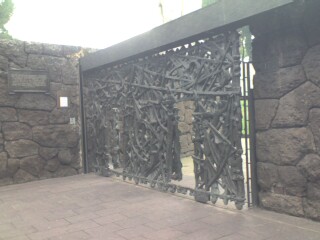
Iron gate at entrance to Ardeatine memorial
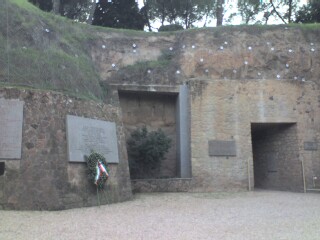
Entrance to Ardeatine Cave
We continue down the Via Appia Antica for as long as we can---at this point, there are big estates with high walls but we can catch glimpses of beautiful gardens through the gates.
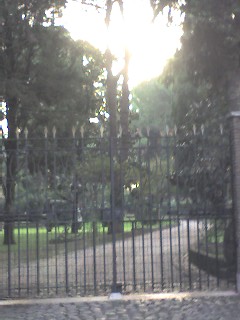
Garden of estate on Via Appia Antica
We head out of Rome on the new Via Appia but just before we leave the city, we make a detour to see what the Appia Antica looks like. We find the road next to the monument called Casal Rotondo, a large circular tomb. The setting could be out in the countryside but we are still within the city limits. There are bikers, joggers and walkers enjoying the late Sunday afternoon
--the sunset is quite beautiful
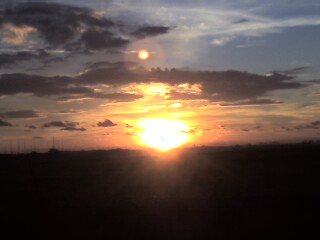
--and there is also a large flock of sheep coming out of the field next to the Casal Rotondo and crossing over the Via Appia Antica.
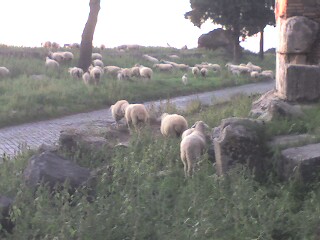
Back in Frascati, I make a exploratory trip into town to find a suitable restaurant for dinner. Most of the recommended restaurants in town are closed on Sunday evenings but I find plenty of attractive possibilities. The town is still full of day trippers and locals on their Sunday evening passeggiata and the porchetta stands are doing a good business.
We end up eating at a place recommended by the desk clerk called Aranua. When we arrive, the place is not too full, but after we order, the tables begin to fill up. We then see that this is another place where just about every table orders the house antipasto which is brought out of the kitchen on several plates. The food is quite good....strozzapreti with cacio, pepe and mushrooms for me and strozzapreti amatriciana for Diana. For secondi, Diana has the sliced steak...it comes very rare and is very good...and I have the "straccetti (rags)"---thin sliced pieces of piece served with lots of rucola. The waitress recommends the Nero d'Avola--a red wine from Sicily--which we enjoy very much.
By the time we make our way back to the hotel, the crowds have left and it is peaceful. Tomorrow, we explore the Colli Albani and the two volcanic lakes.
Tenuta Pantano Borghese
The farm is located behind a security gate and down a long road lined with plane trees. We meet the owners--Federico and Monica Cavazza and they take us on a tour of the property. There are 15 apartments (most of them recently refurbished and tastefully but simply furnished) and a large dining hall with a professional kitchen. In addition to taking in guests, the farm also hosts weddings and other large parties that Monica arranges. She tells us that she will be supervising a lunch for 150 people next week...as part of the inauguration of the fox hunting season (her husband is one the leaders of the local fox hunting group) which will be held on the property. In fact, she invites us to come--to watch the fox hunting but more to enjoy the homemade pasta.
In the back of the buildings--which are built on the foundation of an aqueduct that passed through the property--there are about 300 cows in pens. This is a working dairy farm although the owners are very critical of all the Italian and EU regulations which are constantly changing and making it difficult for them to farm. In fact, they will start marketing their milk directly because the current agricultural policy has been paying them not to produce and they want to keep the farm going as a working farm as well as an agriturismo.

Tenuta Pantano Borghese main building

Cows in pens in back of Tenuta Pantano Borghese
It turns out that Federico is a Borghese count and the farm has been in his family since the 1600's. Monica and Federico invite us for some coffee and cake and we hit it off very well. We have a very pleasant chat about the travel business, the difficulties connected with operating a farm, their experience with getting the business started as well as their family trip around New England and Quebec in a motor home last summer. After our tour of the apartments, Federico invites us to come with him to another horse club event--where many of the members of the fox hunting set get together for a show of the horses that are being used this year as well as demonstration of jumping and cross-country racing.
We follow him from Pantano Borghese to the horse club...which is located just inside the ring road that goes around Rome and just off the Appian Way. The setting is in a very green and bucolic area, almost within the city limits of Rome. In order to get to the stables, we actually have to drive for a short way on the Appian Way with the old stones in the roadway.

A wide view of the riding area

Riders galloping across the fields

The riders of the future
This is a glimpse into a piece of Italian life that we didn't even know existed....fox hunting was brought to Italy about 100 years ago. The people we see at this event are both Italians and foreigners--but from their dress, we could be somewhere in England. We watch the jumping and the riding for a while--many of the riders at this event are policemen and military--and then thank Federico and say goodbye. He urges us to come back to Pantano Borghese next week for the first fox hunt of the season.
We drive back to Frascati for lunch....the porchetta stands in the Piazza del Mercato are too inviting. On this overcast Sunday afternoon, Frascati is very lively....there is a monthly craft/antique sale that fills the main piazza and the streets of the "centro storico". There are four porchetta stands open but one of them is staffed by a natural salesmen who hawks his product aggessively and offers tastes to all who walk by. We order two sandwiches--delicious moist roast pig with savory spices in the middle and crispy skin on wonderful, fresh rosetta rolls--and eat them on a bench in the square.

Porchetta
After lunch, we drive back into Rome; it is Sunday afternoon and the traffic is quite light. My goal is to see the Via Appia Antica (Appian Way) and the memorial at the Ardeatine Caves (Fosse Ardeatine) where more than 300 Romans were massacred as a reprisal for a partisan bomb that killed 33 German soldiers in 1944. I drive straight down the Via Appia Nuova almost to the center of Rome, go past San Giovanni Laterano and down to the Circus Maximus. Along the west side of the Via Appia Nuova, it is still undeveloped for a long stretch and you can see the remains of Roman buildings in the fields. The Via Appia Antica is closed to car traffic until 4 pm (another half hour) so I try to negotiate the confusing Rome traffic patterns to get as close to some of the monuments as possible. After wandering around a residential neighborhood for a while, we find ourselves right along the wall near the Porta San Sebastiano and follow the traffic right onto the Appian Way (even though it is a bit before 4 pm.) The road at this point is lined with high walls and it hard to see anything. We pass the Ristorante Quo Vadis and soon come to the catacombs of St. Calisto....there are a lot of tour buses and a good number of tourists there. Continuing on, we reach the Via Ardeatine and the entrance to the memorial.
The memorial is set in old catacombs which are the actual caves where the Germans executed the Romans who were rounded up quickly--both political prisoners and people from the streets. Out of the 332 murdered, about 80 were Roman Jews, but the killings were specifically reprisals for the killing of the German soldiers and not necessarily part of the plan to exterminate Jews. The tunnels go back under the hill and there are plaques showing where the Germans set off bombs to seal off the caves to conceal the evidence of the murders. There is also a large cemetery covered with a thick concrete roof where the victims are buried and a small museum with exhibits and documentation about the event. There is one large statue commemorating the victims and the gate to the memorial is also a work of art dedicated to them.

Iron gate at entrance to Ardeatine memorial

Entrance to Ardeatine Cave
We continue down the Via Appia Antica for as long as we can---at this point, there are big estates with high walls but we can catch glimpses of beautiful gardens through the gates.

Garden of estate on Via Appia Antica
We head out of Rome on the new Via Appia but just before we leave the city, we make a detour to see what the Appia Antica looks like. We find the road next to the monument called Casal Rotondo, a large circular tomb. The setting could be out in the countryside but we are still within the city limits. There are bikers, joggers and walkers enjoying the late Sunday afternoon
--the sunset is quite beautiful

--and there is also a large flock of sheep coming out of the field next to the Casal Rotondo and crossing over the Via Appia Antica.

Back in Frascati, I make a exploratory trip into town to find a suitable restaurant for dinner. Most of the recommended restaurants in town are closed on Sunday evenings but I find plenty of attractive possibilities. The town is still full of day trippers and locals on their Sunday evening passeggiata and the porchetta stands are doing a good business.
We end up eating at a place recommended by the desk clerk called Aranua. When we arrive, the place is not too full, but after we order, the tables begin to fill up. We then see that this is another place where just about every table orders the house antipasto which is brought out of the kitchen on several plates. The food is quite good....strozzapreti with cacio, pepe and mushrooms for me and strozzapreti amatriciana for Diana. For secondi, Diana has the sliced steak...it comes very rare and is very good...and I have the "straccetti (rags)"---thin sliced pieces of piece served with lots of rucola. The waitress recommends the Nero d'Avola--a red wine from Sicily--which we enjoy very much.
By the time we make our way back to the hotel, the crowds have left and it is peaceful. Tomorrow, we explore the Colli Albani and the two volcanic lakes.
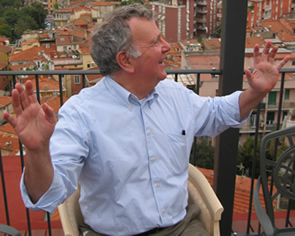

0 Comments:
Post a Comment
<< Home